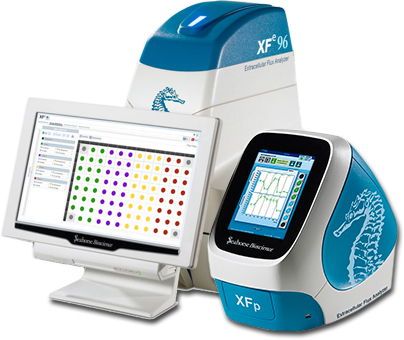Written by Daniel Fritz and Judi Hollander
When studying the phenotype of a particular cell line or observing changes after cell treatment it is often desirable to establish the relative contributions of various metabolic pathways. Agilent’s (formerly Seahorse Bioscience’s) Seahorse XF Analyzer fulfills the role of a capable, easy-to-use platform to gather important bioenergetic data, all in real time. While this instrument has been around for roughly ten years, it had been relegated to niche fields and saw relatively little exposure. In fact, many of you may not be aware that Tufts recently purchased one (a Seahorse XFe96, in case you were wondering)! With more labs and fields now considering the details of cell metabolism within the framework of their research, the Seahorse XF Analyzer (or “Seahorse”, for short) has become something of a gold standard when discussing cellular metabolism profiles and nutrient preference. With the addition of a Seahorse analyzer to Sackler, now is as good a time as any to consider adding this instrument to your toolbox.
At this point you may be thinking, “Dan, Judi, this all sounds great, but what exactly does it do?” Good question! Let’s discuss what exactly the Seahorse XF Analyzer measures and how it does so. Principally, the Seahorse investigates the balance of mitochondrial oxidative phosphorylation and glycolysis within a population of cells. The instrument is loaded with a stacked double plate. The lower plate is a relatively simple multi-well plate that the researcher seeds with the cells of study. The cells form a monolayer along the bottom with a small volume of media on top. The upper plate consists of probes for each well and four small-volume drug ports per well where the researcher can preload the compounds of interest in order to test the cells’ metabolic response. The instrument is programmed to inject specific drug ports at precise times and the well-specific probes are lowered into the media to form a microchamber where pH and oxygen level within the media can be measured. Changes in pH and oxygen level are a consequence of the cells undergoing metabolic processes in response to the drug treatment. The analyzer can then calculate the rate of change in these parameters, resulting in Extracellular Acidification Rate (ECAR) and Oxygen Consumption Rate (OCR), respectively. These parameters are indicative of how fast glycolysis and mitochondrial oxidative phosphorylation metabolic pathways are working.
With Seahorse, the most important part of your assay will be determining what question you want to ask. Because of its sensitivity and capabilities, it is very easy to get lost in the amount of data you are collecting. To aid you in your research, Agilent has a variety of kits available that can answer common questions, and their representatives are more than happy to work with you to develop a custom assay to fit your needs. Each kit supplies a pre-measured amount of certain drugs, which are injected into wells during the assay.
| Questions | Assay |
|
Glycolytic Rate Assay |
|
Cell Mito Stress Test |
|
Cell Energy Phenotype Test |
|
Mito Fuel Flex Test |
|
Glycolysis Stress Test |
Additional information can be found at Agilent’s site: http://www.agilent.com/en-us/products/cell-analysis-(seahorse)/seahorse-analyzers?sh_0015

